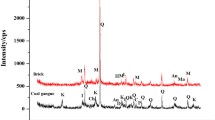Abstract
Peat, ice deposits and aquatic sediments, which have been used as a geochemical monitor of atmospheric heavy metal pollution until now, are open and dynamic systems and can be easily affected by climatic variations. In contrast, bricks, which are more compact, can act as a better geochemical monitor. Analysis of Cu, Cr, Ni, Pb and Zn in scores of soil and brick (baked/unbaked) samples, collected from a large area in and around a rapidly growing Indian city, Agra, reveals approximately similar concentrations in soils and bricks, thereby showing insignificant fractionation of these metals during brick making. Further, metals concentration in the core of bricks remains unaffected by any significant amount of acidic and alkaline rain. Thus, the feasibility of a novel role of bricks as a geochemical monitor of atmospheric heavy metal pollution has been tested. Utilizing this concept, an attempt has also been made to trace the history of atmospheric copper depositions in the soils of Agra during the last 100 years.
Similar content being viewed by others
References
Aston, S. R., Bruty, D., Chester, R. and Padgham, R. C.: 1973, ‘Mercury in Lake Sediments: A Possible Indicator of Technological Growth’, Nature (Lond.) 241, 450–451.
Batifal, F. M. and Boutron, C.: 1984, ‘Atmospheric Heavy Metals in High Altitude Surface Snows from Mont Blanc, French Alps’, Atmos. Environ. 18, 2507–2515
Bertine, K. K. and Goldberg, E. D.: 1977, ‘History of Heavy Metal Pollution in the Southern California Coastal Zone-A Reprise’, Environ, Sci, Technol. 11, 297–299.
Bohn, H. L.: 1972, ‘Soil Absorption of Air Pollutants’, J. Environ. Quality 1, 372–377.
Boutron, C. F., Gorlach, U., Candelone, J., Bolshov, M. A. and Delmas, R. J.: 1991, ‘Decrease in Anthropogenic Lead, Cadmium and Zinc in Greenland Snows Since the Late 1960s’, Nature (Lond.) 353, 153–156.
Farmer, J. G., Swan, D. S. and Baxter, M. S.: 1980, ‘Records and Sources of Metal Pollutants in a Dated Loch Lomond Sediment Core’, Sci. Total Environ. 16, 131–147.
Goldberg, E. D., Gamble, E., Griffin, J. J. and Koide, M.: 1977, ‘Pollution History of Narragansett Bay as recorded in its Sediments’, Estuar. Coast. Mar. Sci. 5, 549–561.
Greenberg, A. E., Trussell, R. R., Clesceri, L. S. and Franson, M. A. H.: 1985, Standard Methods for the examination of Water and Waste Water, APHA, AWWA, WPCF, Washington.
Hamilton, T. J.: 1979, ‘Enrichments of Zinc, Lead and Copper in Recent Sediments of Windermere, England’, Environ. Sci. Technol. 13, 693–697.
Hamilton, T. J.: 1983, ‘Heavy Metal Enrichments in the Recent Sediments of Six Lakes in North-west England’, Environ. Technol. Lett. 4, 115–12.
Kemp, A. L. W., Williams, J. D. H., Thomas, R. L. and Gregory, M. L.: 1978, ‘Impact of Man's Activities on the Chemical Composition of the Sediments of Lakes Superior and Huron’, Water, Air, Soil Pollut. 10, 381–402.
Livett, E. A., Lee, J. A. and Tallis, J. H.: 1979, ‘Lead, Zinc and Copper Analyses of British Blanket Peats’, J. Ecol. 67, 865–891.
Nriagu, J. O., Kemp, A. L. W., Wong, H. K. T. and Harper, N.: 1979, ‘Sedimentary Record of Heavy Metal Pollution in Lake Erie’, Geochim. Cosmochim. Acta, 43, 247–258.
Rippey, B., Murphy, R. J. and Kyle, S. W.: 1982, ‘Anthropogenically Derived Changes in the Sedimentary Flux of Mg, Cr, Ni, Cu, Zn, Hg, Pb and P in Lough Neagh, Northern Ireland’, Environ. Sci. Technol. 16, 23–30.
Ruhling, A. and Tyler, G.: 1984, ‘Recent Changes in the Deposition of Heavy Metals in Northern Europe’, Water, Air, Soil Pollut. 22, 173–180.
Thomas, M., Petit, D. and Lamberts, L.: 1984, ‘Pond Sediments as Historical record of Heavy Metals fallout’, Water, Air, Soil Pollut, 23, 51–59.
Ure, A. M. and Bowen, M. L., (eds.): 1982, Environmental Chemistry, Vol. 2, The Royal Society of Chemistry, London, pp. 94–204.
Weast, R. C.: 1988, CRC Handbook of Chemistry and Physics, Boca Raton, Florida.
Wong, H. K. T., Nriagu, J. O. and Coker, R. D.: 1984, ‘Atmospheric Input of Heavy Metals Chronicled in Lake Sediments of the Algonquin Provincial Park, Ontario, Canada’, Chem. Geol. 44, 198–201.
Author information
Authors and Affiliations
Rights and permissions
About this article
Cite this article
Shrivastav, R., Mathur, S.K., Shrivastav, S. et al. Bricks as historical record of heavy metals fallout: Study on copper accumulation in Agra soils since 1910. Environ Monit Assess 40, 271–278 (1996). https://doi.org/10.1007/BF00398872
Received:
Revised:
Issue Date:
DOI: https://doi.org/10.1007/BF00398872




